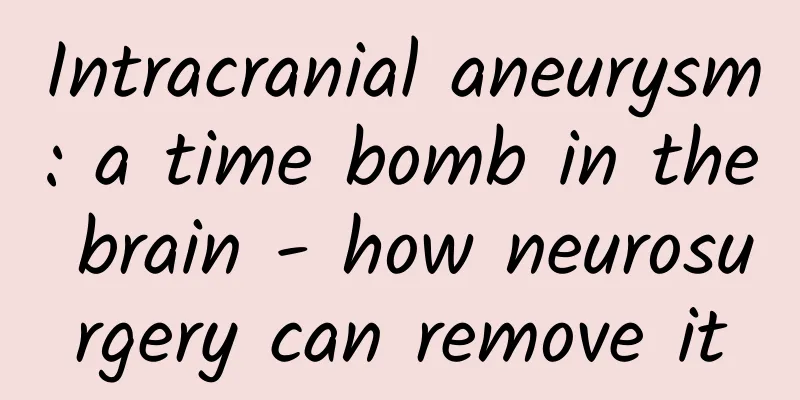Intracranial aneurysm: a time bomb in the brain - how neurosurgery can remove it

|
There are many unknown "secrets" hidden in the most sophisticated and complex "headquarters" of the human body - the brain. Intracranial aneurysm is one of the diseases that threaten people's health like a "time bomb". Neurosurgeons need to use superb skills and advanced technology to carefully "remove" it. Intracranial aneurysms are not true tumors, but abnormal bulges on the walls of intracranial arteries. Under the influence of long-term hemodynamics or due to lesions in the blood vessels themselves, normal blood vessel walls may gradually form local weak areas, causing the arterial walls to bulge like a balloon, forming an aneurysm. This type of aneurysm is like a "time bomb" buried in the brain. It may not have any symptoms and is difficult to detect, but once it ruptures, the consequences will be disastrous. After an aneurysm ruptures, the blood in the artery will instantly flow into the space around the brain tissue, causing intracranial hemorrhage. This will cause a sharp increase in intracranial pressure, compressing the surrounding brain tissue and nerve structures, causing symptoms such as headaches, dizziness, vomiting, blurred vision, and even catastrophic consequences such as coma, hemiplegia, and death in severe cases. According to statistics, once an intracranial aneurysm ruptures, the mortality rate of the first hemorrhage is as high as 30%, and the mortality rate of the second rupture hemorrhage is as high as 60% - 70%. Its danger is self-evident. However, facing this "time bomb" in the brain, neurosurgeons are not helpless. Modern medicine provides a variety of methods for the treatment of intracranial aneurysms, each of which is like a carefully planned "battle" that requires doctors to develop personalized treatment plans based on the patient's specific situation. Currently, the main methods for treating intracranial aneurysms include surgical clipping and vascular interventional therapy. Surgical clipping is like putting a "clip" on the neck of the aneurysm to separate the aneurysm from the normal blood vessels and prevent the blood in the artery from flowing into the aneurysm, thereby preventing the aneurysm from rupturing. The advantages of this method are firm clipping, relatively low recurrence rate, and suitable for various complex aneurysms. However, surgical clipping requires craniotomy, which is more traumatic and requires a high physical condition of the patient. Vascular interventional therapy is a less invasive treatment method. It uses a catheter in the blood vessel to deliver special materials, such as coils and stents, into the aneurysm cavity, fill the cavity, and form a blood clot inside the aneurysm, thereby achieving the purpose of sealing the aneurysm. This method is like placing a "plug" inside the aneurysm to block the "hole" of the aneurysm. Vascular interventional therapy does not require craniotomy, is less traumatic to the patient, and recovers faster, but for some complex aneurysms, the treatment effect may not be ideal. In addition to directly treating the aneurysm itself, neurosurgeons also focus on the patient's postoperative rehabilitation and prevention of recurrence. After surgery, doctors will closely observe the patient's vital signs and nervous system function, provide symptomatic treatment and rehabilitation guidance, and help the patient recover as soon as possible. At the same time, in order to reduce the recurrence rate of aneurysms, doctors will help patients control risk factors such as blood pressure and blood lipids, conduct regular follow-up examinations, and promptly detect and deal with possible problems. Although intracranial aneurysm is a disease that seriously threatens people's health, as long as we can detect, diagnose and treat it early, and through the careful treatment of neurosurgeons, we can remove this "time bomb" in the brain and protect the health of the brain. In the future, with the continuous advancement and innovation of medical technology, I believe that our understanding and treatment of intracranial aneurysms will continue to improve, protecting the lives and health of more patients. |
<<: Inflammation of blood vessels?
>>: "Aimeiyi" prevention and treatment knowledge series - Syphilis
Recommend
What causes sudden amenorrhea?
Women’s menstruation can reflect their physical h...
Pregnancy due date in June
Many newlyweds plan to have a baby soon after the...
Can Ibuprofen relieve menstrual cramps?
Menstrual cramps have always been a very troubles...
How to prevent steamed buns from becoming hard after cooling? How to adjust the filling of steamed buns with vermicelli filling?
Baozi, formerly known as steamed bread, is also k...
What are the side effects of long-term use of Clemen?
Clemenor is a relatively common drug that can tre...
How can I mail crabs alive? Can I reheat crabs if they are cold?
In ancient times, crabs were considered as one of...
What are the new methods for treating uterine fibroids?
As women are under increasing pressure, their sle...
How to remove mole scars, homemade scar removal mask
Mole removal is the use of some artificial means ...
Girls' calf stretching exercise diagram
Nowadays, women pay more and more attention to th...
The power of fermentation: the contribution of production technology to the nutritional value of cheese
Cheese is one of people's favorite dairy prod...
Women's sexual function maintains age
Many people say that as women age, their sexual n...
What is the “white” in front of you?
This is the 3600th article of Da Yi Xiao Hu Be ca...
B-ultrasound does not show pregnancy
For some women who have just become pregnant, the...
What are the ingredients of mascara? What should I do if my mascara dries up?
Mascara is a must-have item for female friends to...
Black stool in early pregnancy
We often encounter problems such as diarrhea and ...









